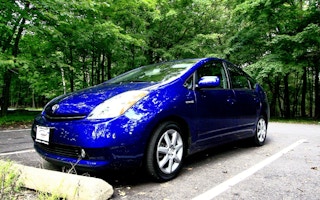In 1997, Toyota established itself as a leader in low carbon transport with the release of the Prius, the world’s first passenger hybrid vehicle. The company took a risk on a new technology, and it paid off with a bestseller.
To continue reading, subscribe to Eco‑Business.
There's something for everyone. We offer a range of subscription plans.
- Access our stories and receive our Insights Weekly newsletter with the free EB Member plan.
- Unlock unlimited access to our content and archive with EB Circle.
- Publish your content with EB Premium.
Twenty-five years later, the Prius is no longer the most environmentally friendly car on the market. Toyota’s competitors, such as GM, Hyundai and Tesla, have introduced a growing selection of zero-emission vehicles. More than two decades after the Prius first hit the road, Toyota is falling behind when it comes to climate action.
Toyota is increasingly known for its lobbying efforts against climate-friendly legislation. Last fall, the think tank Influence Map found Toyota to be the third worst offender worldwide when it came to obstruction of climate legislation, behind ExxonMobil and Chevron. In 2021, Toyota recorded the lowest proportion of zero-emission vehicle sales of the world’s biggest car companies, at a mere 0.2 per cent.
By contrast, governments in many of Toyota’s biggest markets have already begun to implement bans on combustion engine vehicles. The European Union has prohibited the sale of new internal combustion engine (ICE) vehicles by 2035, and the US has targeted that 50 per cent of vehicles sold are electric by 2030. On an even more ambitious timeline, the UK banned the sale of all ICE vehicles by 2030.
In response, EV sales have taken off. Global sales of EVs doubled in 2021, and sales nearly tripled in China. A recent analysis from Bloomberg found that when the rate of new EV sales exceeds 5 per cent, adoption rapidly accelerates. The US, Europe and China, which comprise roughly 60 per cent of Toyota’s total market, have each passed the five per cent milestone already, setting the stage for rapid market growth.
Toyota’s competitors are speeding toward EV dominance, including in Toyota’s home market of Japan. Tesla has taken the lead in Japan’s small but growing EV market, a position that is perhaps surprising in a context that overwhelmingly favours domestic automakers. Chinese automaker BYD, which exclusively manufactures full electric vehicles and plug-in hybrids, announced last month that it would enter the Japanese market from 2023, and Hyundai is returning to Japan for the first time in more than a decade with a zero-emission vehicle-only strategy.
Meanwhile, investors have increasingly begun to question Toyota’s environmental record. In April of last year, Danish pension fund Akademiker Pension submitted a shareholder resolution to Toyota that expressed “serious concerns over [Toyota’s] ongoing climate lobbying.” The pension fund argued that Toyota had sought to weaken government efforts to phase out internal combustion vehicles, alleging that negative climate lobbying was harmful to the company’s brand.
However, many of Toyota’s most vocal critics point out that it is not too late for the company to reverse course. First, Toyota can speed up its phase-out of combustion engine vehicles, with the goal to reduce tailpipe emissions to zero by 2030. Second, Toyota should decarbonise its supply chain by setting targets for resource recycling and circularity. Third, Toyota must prioritise the well-being of its employees and ensure that workers’ demands are met during this time of rapid industry transition.
In 1997, Toyota revealed its capacity to innovate when it sold the world’s first passenger hybrid vehicle, a decision that has helped to sustain the brand’s strength over the past 25 years. In 2022, we are experiencing climate change with a new level of intensity, and record-setting heat waves, hurricanes and droughts are becoming the norm.
As the largest carmaker in the world, Toyota must channel the same sense of innovation that enabled it to develop the Prius and work to tackle these challenges.
We can’t afford for Toyota to hold the world back.
Daniel Read is a campaigner for environmental protection group Greenpeace East Asia, based in Tokyo.











